Pg 1/ Pg 2
(The Study of Threes)
http://threesology.org
Researchers as of 12/6/2019
One of the biggest issues concerning dualities is their presence and placement among other number entities such as monism's, triplicities, etc., is that when they are recognized and catalogued, we find that the existence of a 1 - 2 - 3 maturational development sequence in Biology is not absorbed into a conceptual holistic (wholistic... whole-istic) framework. In other words, whereas we can easily identify the many lists of dualities offered by different observers of the Yin/Yang profile, we do not see this placed into a realization that the Chinese tried to go beyond the "2" and develop a "3" idea that we see expressed in the labeled Triads of the I-Ching. Though they are actually embellished dichotomies (having only 1 and 2-line configurations which are repeated without the usage of an actual 3-line configuration), the point is that the ancient Chinese made an attempt to reach some formalization of a "3".
As time passed and Civilizations further west began to develop, we see the development of a "sophisticated rudimentary model of Mathematics" with the usage of dichotomies that no one... until I decided to put a list together, has openly illustrated as another model of the same type of human brain creating a differently shaped... symbolic perspective of the world which adhered to the same dual-formula structure. In addition, the underlying dichotomous nature of so-called Modern Mathematics has itself striven for a "threes" orientation by the usage of such ideas as Trigonometry, the Pythagorean theorem (A2 + B2 = C2), etc., along with Einstein's equation of E = MC2 (Energy equals Mass times the speed of light squared).
Another example is the usage of two numbers (zero and one) for the present day computer language based on electrical switching. This duality, called a Binary code, is also undergoing an attempt to reach some semblance of a "three" energy state by the application of Boolean logic and its three basic options (called "gates"): AND gate, OR gate, NOT gate. However, to reach a more realistic "three" reality, there are those attempting to reach it by way of developing a new type of computer operating system called Quantum computing with a Trinary (or ternary) language.
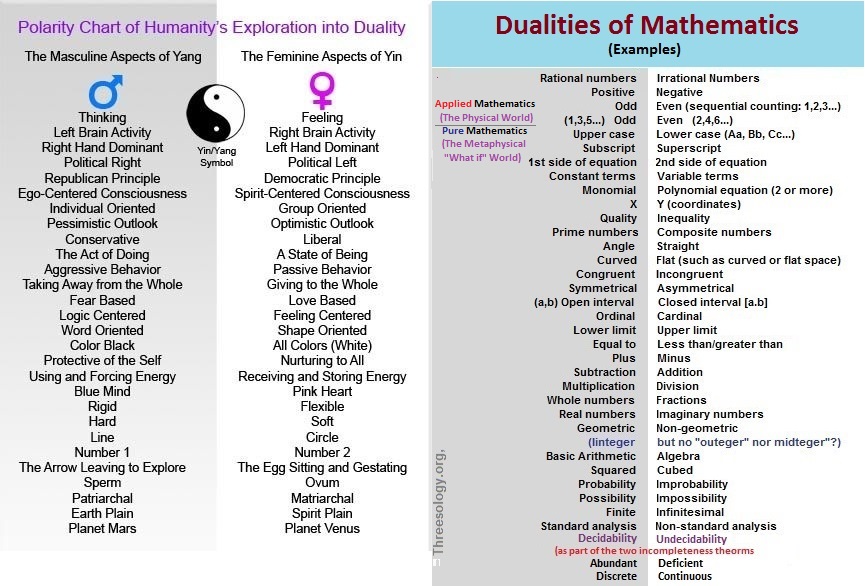
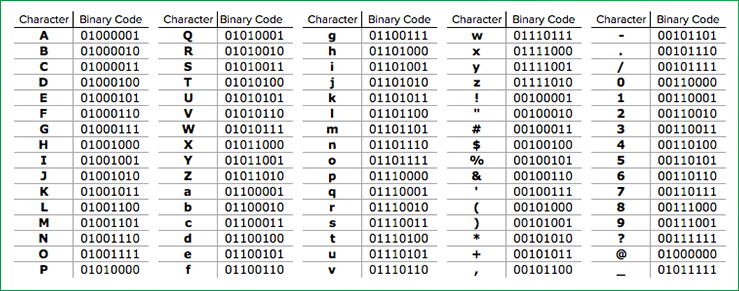
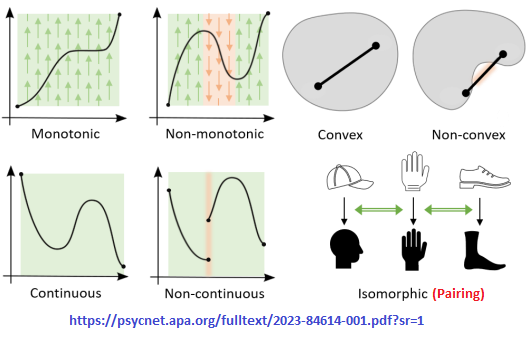
The Psychological Scaffolding of Arithmetic
by Matt Grice, Simon Kemp, Nicola J. Morton, and Randolph C. Grace
In each of three examples of dualities (called binary or not), we find that the mind of humans as attempted to exceed the "2" by developing some semblance of a "3". In terms of the Yin/Yang profile, we pay witness to the later development of the presumed Triads in the I-Ching. However, the so-called Triads are actually Byads (since no actual 3-part line is used), thus revealing what I call is an Embellished duality using language and pictorial arrangements to describe a desire to "go beyond the two".
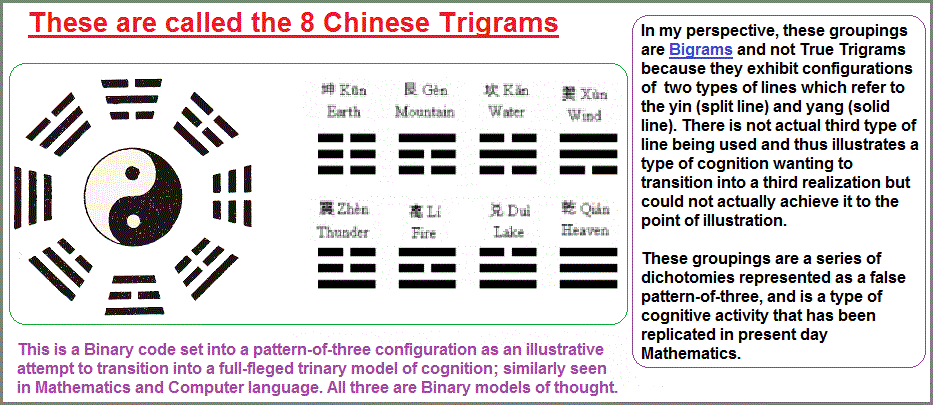
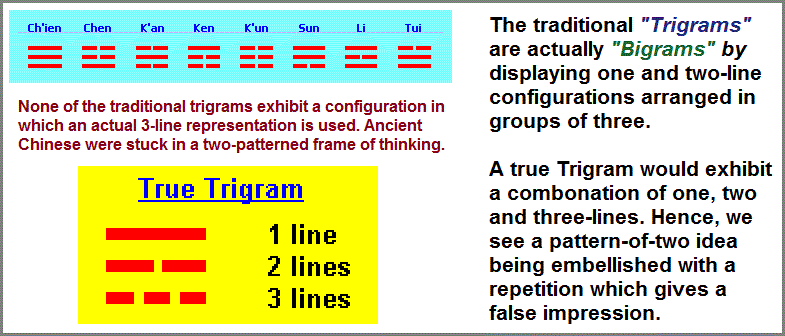
Note: The single line is Yang, or the male "principle" (penis) and the double line is the Yin, or the female "principle" (vagina). By associating the yin and yang to gender, we are confronted by a non-existent gender... even if an hermaphroditic argument is selected as an option. The Ancient Chinese did not have a real type of gender by which to create a 3-line configuration to associate it with, even though they attempted to intellectually achieve a conceptualization beyond the former Yin/Yang twoness by combining different proportions of a single and double line into a 3-part illustration called a Triad. This is an example of the human mind indulging in an Ebellished Dichotomy. We see the same thing occurring in Mathematics and Computer language. An overt social expression of this cognitive exercise to reach some formula of the "3" is seen in Hitler's Third Reich and the prevailing idea of the world near the edge of a 3rd World War. In some cases the effort is to supplant a proposed three configuration and represent a multiplicity as if all the world is engaged in a game of one-upmanship.
In the case of Mathematics, we again see an attempt by the mind of humans to go beyond the underlying use of dualities by developing such ideas as Trigonometry and Boolean Algebra, the latter being applied as a presumed Trichotomy to the dualities of of the binary code used in Computer language. And in the case of the dualities used in computers, what we see are those attempts by a few to develop a Trinary computing language best befitting a hoped-for state of superior Quantum computing.
Here are some Mathematical dualities culled from 50 Centuries in 50 Minutes (A Brief History of Mathematics) by John Dersch:
John Napiers (Scotish) had the brilliant idea (from trigometric identity [product to sum] ) that you could transform:
- Multiplication into Addition
- Products into Sums
- Quotients into differences
- Powers into Multiplication
- Roots into Division
- Rhetorical Mathematics/ Symbolic Mathematics
- potential versus actual infinity
- tangent line problem inverse of area problem
Whereas many people see the dualities, they don't composite them into a listed fashion nor think of them in terms of a basic and recurring (patternized) formula of human conceptualization that we can compare with other subjects in other countries from other time periods. The commonality of Dualities as precursors to attempted Trichotomies not only escapes their notice, but they may become violently opposed to any supposed Anthropologically oriented application of dissection and interpretation related to the cognitive development of humanity... if not existing as a basic formula in the evolutionary activity of other life forms, such as the 1- 2- 3 germs layers development over time and the similarity of development which took place with the genetic code... if not strandedness of RNA and DNA. Mathematics, like the Yin/Yang idea, like biological development are existing remnants of the past which in some cases may take place in a multi-language form or require those of us in the present to effect the development of a Rosetta Stone-like structuring in order the enabling of ourselves to better grasp a truth that exists in bits and pieces in different places, times and forms.
 Symmetries, Duality, and the Unity of Physics Nathan Seiberg |
 Duality (in art) by 13FOREST Gallery Jon Cowan & Lindsey Kocur |
 Dual Natured Architecture by Argitect |
 Dualism Revised Fri. Sep 11, 2020 |
 Britannica: Structuration Theory Restructuring Restruction Theory |
 Special Issue on Dualities E. Castellani & D. Rickles |
The title of this page comes from an excellent outline of Lecture material provided by Dr. Street:
PSYCHOLOGY 461K
HISTORY AND SYSTEMS OF PSYCHOLOGY,
DR. Warren R. Street
Warren Street retired from Central Washington University in 2008.)
I chanced upon the forth-coming list as I was rummaging about the internet in search of "two-patterned" examples featured as dualities or dichotomies to be used as part of a discussion on one of the pages for the Novum Organum Threesiarum preface page A section. And even though I am familiar with many of those selectively listed, it has been more years than I can remember when I last took a psychology course. Humorously, it was during an age when Freud was still in diapers (though he had a beard even then). Yet I don't in any particular way remember being introduced to the idea concerning the persistence of dichotomies. In retrospect, a profile of dichotomous thinking does in fact persist as highlighted by Dr. Street. Each of us uses our own variations of a dichotomous perspective from time to time.
Stated as such, it is necessary to point out the need for a distinction with respect to dichotomies (or if you prefer, dualities). The realization which should more rightly be proffered is that there is a Persistence of Dichotomization. At least in some respects, and obviously used quite often when philosophically discussing aspects of psychology. While some may want to argue that such a persistence in thinking is due to the actual presence of dichotomies (such as two eyes, two ears, etc...), it should be noted that an alternative array of dichotomies (or dualities) does not typically accompany nor become accumulated in a similar manner as does a listing of various trichotomies.
Let me now present the list of dichotomies exhibited on Dr. Street's page which will be followed by additional examples compiled by other "dual-focused" individualized perspectives:
|
Here is a short excerpt viewing dichotomies in the context of a psychological system which are part of a larger course in Theoretical Backgrounds in Psychology
|
With regard to the problem of what is ideally entailed by a psychological system, Marx and Cronan-Hillix dealt with Robert Watson's "prescriptions" and with a study by Coan who had psychological theories assessed on a number of bipolar dimensions. In an attempt to make up for the lack of a psychological paradigm, Watson (1967, p. 436; 1971, p. 315; Fuchs & Kawash, 1974) isolated eighteen themes or prescriptions:
(prescriptions 5, 10, 14 have been quoted in reverse order.) The list is a little unsystematic, it will be noted. Contentual, methodological, and philosophical prescriptions have been stated in no apparent order, and some seem to overlap. Moreover, concepts such as rationalism and staticism are used in more than one sense while the meaning of the first prescription in particular leaves the present author in the dark. In coan's study (1968, 1973), six bipolar factors were found in a factor-analysis of 34 variables. The list is conveniently short compared to Watson's but its general similarity with the prescription is easily grasped:
Recently, the same number of dimensions was found by Kimble (1984). In an attempt to describe "psychology's two cultures", (cf. Schopman, 1989, Stagner, 1988) Kimple came up with the following list:
(Edited by Hans V. Rappard, Pieter J. Van Strien, Leendert P. Mos and William J. Baker) |
(J. E. Bogen)
| Left Hemisphere | Right Hemisphere |
| Intellect | Intuition |
| Convergent | Divergent |
| Digital | Analogic |
| Secondary | Primary |
| Abstract | Concrete |
| Directed | Free |
| Propositional | Imaginative |
| Analytic | Relational |
| Lineal | Non-lineal |
| Rational | Intuitive |
| Sequential | Multiple |
| Analytic | Holistic |
| Objective | Subjective |
| Successive | Simultaneous |
(I Ching)
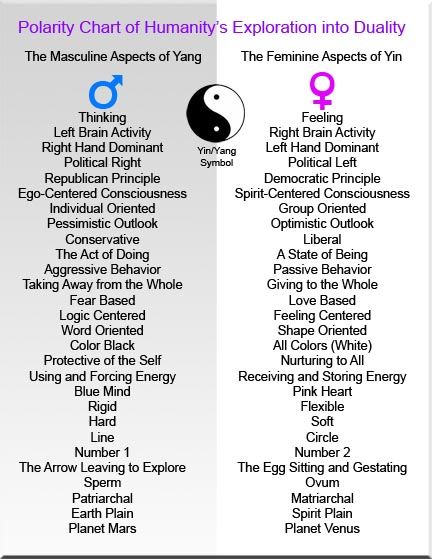 |
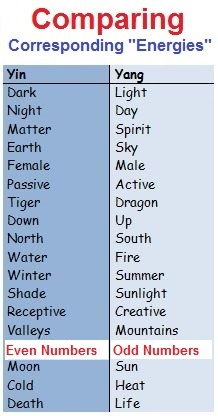 |
While the last two lists were focused on an itemization of brain hemisphere attribute differences, and Dr. Street's list was not, all three of them have the underlying intention of pointing out patterns-of-two as a fundamental thinking formula. And it should be noted that the lists were not generated because the examples were taken out of some otherwise perceived context as a juxtaposed dominating contrariety, since they were actually used in an attempt to diagram a distinction within the context of thinking. It might well be presumed that the authors genuinely thought they were providing an insight into some dominant fundamental pattern. Yet, the lists do not likewise generate the distinction concerning the recurrence of Singularities and Pluralities, with the dominant plurality appearing to be Triplicities.
The lists also do not themselves venture into an attempt to provide the supposition of pristine influence other than to align differences with different brain structures, though Dr. Street's list does not make any such suggestion one way or another. As such, it is rather curious that while the two brain hemispheres can be used to suggest a role in the development of dichotomous ideas, the idea of a triune brain as outlined by Paul D. MacLean has not received an equal weight of organizational influence on three-patterned ideas.
However, I do not want to give the impression that the above two-patterned examples are in any way representative of a limitation having been reached in supplying the reader with examples. There are multiple other examples, but once you have surveyed them as well, you will then be able to describe for yourself that a limitation does in fact exist not only for "twos" in their multiple forms, but all number patterns being used. Let me provide a few more examples of two-patterned groupings, though many of them are aligned around or has some precursor arrangement/relationship to the yin/yang (or yang/yin) concept even if this is not implied.
The following list of dichotomies labeled "dualities" comes from: Wiikipedia: List of dualities, though there is another page described as Wikipedia: Twins in Mythology, as well as other two-patterned collections. We might also want to include: The 35 Greatest TV Duos of All Time by Adam Vitcavage, January 8, 2012, 8:15 am. However, the range in which dichotomies play out in the behavior of gangs and gangsters, political systems, religious systems, economic systems, military leaderships and campaigns, science teams, sports teams, male/female relationships, biological development, atomic particle interactions, planetary events (such as twin stars), language expressions, selective hearing, thinking, etc., has not actually been explored very deeply. Present humanity is pretty superficial, superstitions, and supercilious (or shall we say, engaging in a range of super silliness).
- Alexander duality
- Alvis-Curtis duality
- Beta-dual space
- Coherent duality
- De Groot dual
- Dual abelian variety
- Dual basis in a field extension
- Dual bundle
- Dual curve
- Dual (category theory)
- Dual graph
- Dual group
- Dual object
- Dual pair
- Dual polygon
- Dual polyhedron
- Dual problem
- Dual representation
- Dual q-Hahn polynomials
- Dual q-Krawtchouk polynomials
- Dual space
- Dual topology
- Dual wavelet
- Duality (optimization)
- Duality (order theory)
- Duality of stereotype spaces
- Duality (projective geometry)
- Duality theory for distributive attices
- Dualizing complex
- Dualizing sheaf
- Eckmann-Hilton duality
- Esakia duality
- Fenchel's duality theorem
- Hodge dual
- Jónsson-Tarski duality
- Lagrange duality
- Langlands dual
- Lefschetz duality
- Local Tate duality
- Opposite category
- Poincaré duality
- Poitou-Tate duality
- Pontryagin duality
- S-duality (homotopy theory)
- Schur-Weyl duality
- Serre duality
- Spanier-Whitehead duality
- Stone's duality
- Tannaka-Krein duality
- Verdier duality
Philosophy and religion
Science: Engineering
- Duality (electrical circuits)
- Duality (mechanical engineering)
- Observability/Controllability in control theory
Science: Physics
- Complementarity (physics)
- Dual resonance model
- Duality (electricity and magnetism)
- Englert-Greenberger duality relation
- Holographic duality
- Kramers-Wannier duality
- Mirror symmetry
- 3D mirror symmetry
- Montonen-Olive duality
- Mysterious duality (M-theory)
- Seiberg duality
- String duality
- Wave-particle duality
We could also include words with the "bi" prefix, which stands for two: (Prefix BI).
However, the following list is quite brief when we take in the stock of examples from:
Category: English words prefixed with bi-
- Biangular
- Biannual
- Biaxial
- Bicameral
- Bicapsular
- Bicarbonate
- Bicentennial
- Bicephalous
- Biceps
- Biconcave
- Biconvex
- Bicuspid
- Bicycle
- Biennial
- Bifocals
- Biform
- Bifurcate
- Bigamy
- Bilabial
- Bilateral
- Bilingual
- Bimanual
- Bimonthly
- Binaural
- Binocular
- Binomial
- Biography
- Bipartisan
- Biped
- Biphenyl
- Bipinnate
- Bipolar
- Biracial
- Bisect
- Bisexual
- Bivalve
- Biweekly
- Biyearly
If we then attempt to provide a list of words prefixed with the alternative "di", we run into the situation that it requires multiple pages, so let us hope this link is sufficient for those who are curious: Category: English words prefixed with di-
By comparison, in order to make a specific reference to the fact that not all numbers have quantity-focused prefixes, and that the list is quite small, let me provide a few alternative references to other prefixes highlighting an enumeration, though its actual adopted usage in more familiar and everyday words may be sparse or relatively non-existent. (Metric (SI) Prefixes)
| Prefixes | |||||
| Purpose | Prefix Name | Pronunciation | Prefix Symbol | Value | |
|---|---|---|---|---|---|
larger quantities or whole units |
yotta | yot'uh | Y | 1024 | Septillion |
| zetta | zet'uh | Z | 1021 | Sextillion | |
| exa | ex'a a as in about |
E | 1018 | Quintillion | |
| peta | as in petal | P | 1015 | Quadrillion | |
| tera | as in terrace | T | 1012 | Trillion | |
| giga | jig'a a as in about |
G | 109 | Billion | |
| mega | as in megaphone | M | 106 | Million | |
| kilo | as in kilowatt | k | 103 | Thousand | |
| hecto | heck'toe | h | 102 | Hundred | |
| deka | deck'a a as in about |
da | 101 | Ten | |
| 100 | One | ||||
| smaller quantities or sub units |
deci | as in decimal | d | 10-1 | Tenth |
| centi | as in sentiment | c | 10-2 | Hundredth | |
| milli | as in military | m | 10-3 | Thousandth | |
| micro | as in microphone | µ | 10-6 | Millionth | |
| nano | nan'oh an as in ant |
n | 10-9 | Billionth | |
| pico | peek'oh | p | 10-12 | Trillionth | |
| femto | fem'toe fem as in feminine |
f | 10-15 | Quadrillionth | |
| atto | as in anatomy | a | 10-18 | Quintillionth | |
| zepto | zep'toe | z | 10-21 | Sextillionth | |
| yocto | yok'toe | y | 10-24 | Septillionth | |
| Whole Units | Decimal Units | |||||
| thousands | hundreds | tens | basic unit | tenths | hundredths | thousandths |
|---|---|---|---|---|---|---|
| 1000 | 100 | 10 | 1 | 0.1 | 0.01 | 0.001 |
| kilo- | hecto- | deka- | meter gram liter |
deci- | centi- | milli |
When we get to the more familiar prefixes which have spread to various nooks and crannies of language usage, no doubt due to a longer history of application, let us make note of the greek and Latin variations: (Numerical Prefixes)
- mathematical bases "-al"
- adjectives of relation "-nary"
- groups of musicians "-tet"
- words for multiples of something "-uple"
- number of years between two events "-ennial"
- number of sides of something "-lateral"
- words for large numbers / exponents "-illion"
- less common categories: number of leaflets or petals on a leaf or flower "-foliate", chemical valencies "-valent"; division into parts "-partite" or "-fid".
In this first table, I've listed the Latin words for 1 through 12 along with the appropriate prefix that is derived from it. For each of the above categories, check the appropriate column and find the word list. In cases where the word couldn't be found in regular dictionaries, I've extrapolated from the other words and used appropriate prefixes and endings to construct the correct form. In such hypothetical cases, the word is marked with an asterisk and put it in italics.
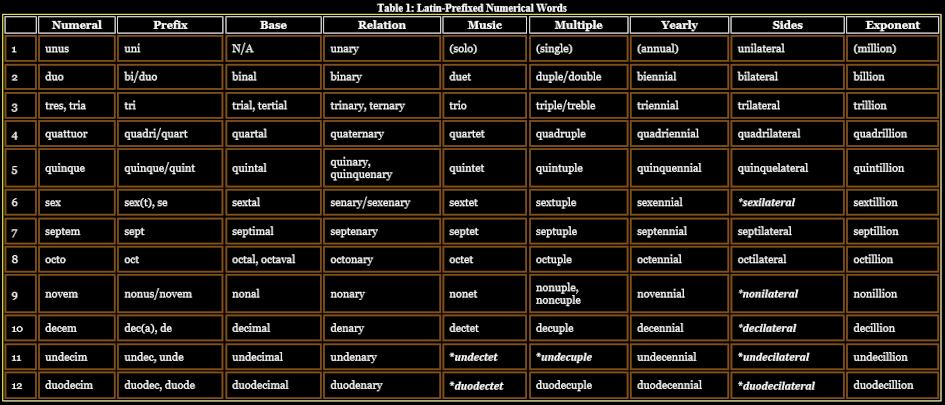
So far, so good. We can see that there are a few exceptions to the general rule, particularly for the numbers 1 and 2, and in some cases such as "quinary / quinquenary" where multiple forms exist. Since I'm not being hardline about "proper" forms, I'm including all the forms normally used, even when they don't strictly follow the rules. Up to 12, the Latin prefixes hold up pretty well; most of the forms exist; only "sexilateral", of all the hypotheticals, is less than nine. My theory is that it sounds too lewd to have been adopted as the term for something with six sides. Well enough, then.
Let's turn to the Greek prefixes (mono, di, tri ...), which are used for the following categories:
- number of angles of plane figures "-gon"
- number of faces of solid figures "-hedron"
- number of angles in a shape or line "-angle"
- number of rulers in a government "-archy"
- number of meters in a poetic verse"-meter"
- number of objects in a group "-ad"
- number of events in an athletic competition "-athlon"
- less common categories: numbers of syllables in words "-syllabic"; sets of books or other works "-logy"; number of fingers "-dactylic"; number of languages spoken "-glot"; number of parts "-merous"; number of columns "-style"; amount of carbon in many chemical molecules "-ane", "-ene", "-yne".
And now, Table 2 shows us the Greek numeral words and prefixes in conjunction with the appropriate suffixes for the above categories.
| Numeral | Prefix | Polygon | Polyhedron | Angle | Ruler | Meter | Group | Event | |
|---|---|---|---|---|---|---|---|---|---|
| 1 | en | mono | N/A | N/A | N/A | monarch | N/A | monad | N/A |
| 2 | dyo/duo/di | di/dy | N/A | N/A | N/A | diarch, dyarch | dimeter | dyad | biathlon |
| 3 | treis, tria | tri | triangle | N/A | triangle | triarch | trimeter | triad | triathlon |
| 4 | tessera | tetra | tetragon | tetrahedron | quadrangle | tetrarch | tetrameter | tetrad | tetrathlon |
| 5 | pente | penta | pentagon | pentahedron | pentangle | pentarch | pentameter | pentad | pentathlon |
| 6 | hexa | hex | hexagon | hexahedron | hexangle | hexarch | hexameter | hexad | *hexathlon |
| 7 | hepta | hept | heptagon | heptahedron | heptangle | heptarch | heptameter | heptad | heptathlon |
| 8 | okto | oct | octagon | octohedron | octangle | octarch | octameter | octad | *octathlon |
| 9 | ennea | ennea | enneagon, nonagon |
enneahedron | *enneangle | *ennearch | *enneameter | ennead | *enneathlon |
| 10 | deka | dec(a) | decagon | decahedron | decangle | decarch | decameter | decad(e) | decathlon |
| 11 | hendeka | hendec(a) | hendecagon, undecagon |
hendecahedron | *hendecangle | hendecarch | *hendecameter | *hendecad | *hendecathlon |
| 12 | dodeka | dodec(a) | dodecagon | dodecahedron | *dodecangle | dodecarch | *dodecameter | dodecad(e) | *dodecathlon |
The situation with the Greek terms is a little more complex than with the Latin, but not excessively so. Latin prefixes are used for some words for polygons, although the Greek prefix is to be preferred. "Biathlon" should, by all rights, be "diathlon", "triangle" is used for a plane figure as well as angles (instead of 'triagon'), and there are very few terms for 1 and 2. Of course, this is partly because there's no such thing as a two-faced polyhedron, and not much point in describing a single athletic event as a "monathlon" ...
So far, we've stuck to the numbers 1 through 12. We have pretty solid sequences of words, although the words relating to 9 and 11 are, to be fair, extremely rare. But moving to the teens, decades, 100 and 1000, the words become much more sparse. Still, given the right adjectives and a little creativity, we can construct many hypothetical words that should be understandable. Table 3 lists the higher Latin numbers and prefixes. I'll stick to listing the numerical bases and adjectives of relation, and let you figure out the rest on your own, on the pattern described above. Most of the other terms aren't found in dictionaries (how often do you need to describe something that recurs every 60 years?), with the exception of those for 20, where terms like vicennial and vigintillion are sometimes used.
Initial Posting date: May, 22, 2014
Updated posting: Thursday, September 30th, 2021... 12:38 PM
Former Update: Monday, February 12th, 2024... 6:55 AM
Latest Update: Sunday, August 18th, 2024... 5:11 AM
Herb O. Buckland
herbobuckland@hotmail.com